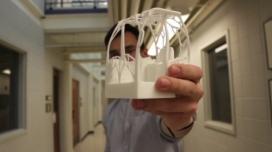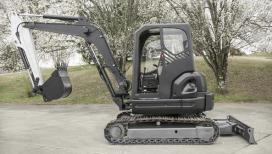Student Team Enables World’s First 3D-Printed Fully Functional Mini-Excavator
A strain energy accumulator was successfully demonstrated on an ankle foot orthosis (AFO) as a way to recover exhaust gas in a pneumatic system. The innovation emerged in research applications at the NSF-funded Engineering Research Center (ERC) for Compact and Efficient Fluid Power (CCEFP), headquartered at the University of Minnesota.
A student engineering team at the University of Illinois at Urbana-Champaign (UIUC) submitted a winning design for an aesthetically pleasing excavator cab that has now become the world’s first 3D printed, fully functioning, steel mini-excavator. Oak Ridge National Laboratory (ORNL) in Knoxville, Tennessee helped fabricate the student-initiated breakthrough construction vehicle, now known simply as AME (pronounced “Amy”), the Additive Manufactured Excavator. The project is also the first large-scale use of 3D printed steel.
The completed AME was introduced as a live Tech Experience at CONEXPO-CON/AGG and IFPE (International Fluid Power Exposition) 2017 in Las Vegas. Over 100,000 visitors attended the students’ display, which was a top attraction at the international trade show for the construction industries.
Naomi Audet, Lucas Meyer, Sharon Tsubaki-Liu, Kevin Kim, and Andrew Peterman teamed up to design and submit their 3D-printed futuristic excavator cab and human machine interface. A panel of industry experts judged the AME design competition and members of the UIUC team received a $2,000 cash prize (donated by the National Fluid Power Association (NFPA)) and a trip to ORNL in Tennessee to observe 3D printing of the innovative excavator cab.
“This project was one of the very top efforts in an extremely competitive field of 28 senior design capstone projects within the MechSE Department at UIUC in the Spring 2016 semester,” said Professor Elizabeth Hsiao-Wecksler, the Department’s Associate Head for Undergraduate Programs. “It had the ideal combination of a challenging project with outstanding ingenuity and hard work by the student team. We think it was a perfect example of what’s being accomplished within our senior design capstone program’s innovative atmosphere.”
An additional grant was soon awarded from NSF to 3D-print a full-scale operational excavator, for the students’ CONEXPO display. CCEFP worked with research teams from Georgia Tech and The University of Minnesota to convert the early excavator design to one that is conducive to and takes full advantage of 3D manufacturing. Graduate engineering students at Georgia Tech created a boom and bucket featuring integrated hydraulics with the goal of decreasing the weight, materials cost and maintenance, while students at the University of Minnesota designed a hydraulic oil heat exchanger and cooling system that reduces the size and weight and increases the efficiency of the machine.
The resulting prototype of the mini-excavator has a 20-foot 3D printed arm, a 30-foot-by-10-foot 3D printed driver’s cab, and several 3D printed engine components. Using the Cincinnati Incorporated Big Area Additive Manufacturing system at ORNL, the cab was printed in just five hours with carbon fiber reinforced ABS plastic. The stick or boom (a large hydraulically articulated arm) of the excavator is seven feet long and weighs 400 pounds (lbs); it was printed entirely in low-cost steel on the Wolf Robotics Wolf Pack printer in only five days. A 13 lb aluminum heat exchanger was 3D printed entirely on the Concept Laser X-line 1000 powder bed 3D printer.
At CONEXPO-CON/AGG and IFPE 2017, AME’s full functionality was shown in action, with the 3D printed prototype digging up dirt. Numerous industry, show, and Department of Energy dignitaries attended AME’s grand unveiling. Students who attended the show said it was a “once in a lifetime experience.”
The complete AME was brought to completion by Lonnie Love, ORNL's Manufacturing Systems Research Group leader, with CCEFP’s consortium of research teams and partners in industry, government and academia. Collaborators include the Association of Equipment Manufacturers (AEM), National Fluid Power Association (NFPA), Center for Compact and Efficient Fluid Power (CCEFP), Oak Ridge National Laboratory (ORNL), and the National Science Foundation (NSF). The Department of Energy’s (DOE) Office of Energy Efficiency and Renewable Energy provided additional funding.



